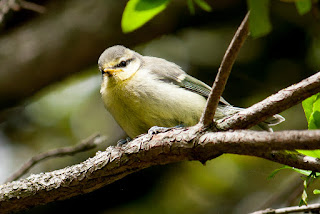A Carrion Crow fed two fledglings on a dead tree near the Italian Garden.
Neil got the first picture this year of a young Blue Tit ...
... and also the mate of the Chaffinch near the Albert Memorial which he photographed last Saturday. Both of the pair are in fine condition and have so far avoided the foot disease which afflicts Chaffinches.
A Grey Heron looked for fish from the fallen horse chestnut tree in the Long Water ...
... and then, just as I was trying to find a better angle, lunged and caught a perch.
The Great Crested Grebes' nest at the west end of the island is a soggy heap of algae. There must be some twigs in it lower down to stop if from falling apart at once.
The rotting mass is full of insects. A Magpie searched for these in the nest on the fallen poplar in the Long Water.
The chick on the Long Water has started following its parent down when it dives. This is how young grebes learn to fish.
The Moorhens at the north end of the Long Water have four chicks. A parent fed two of them, but the other two were already off looking for their own food.
The chicks are strange-looking little creatures, but more attractive to the human eye than Coot chicks.
The moulting geese are now shedding their flight feathers fast. This Canada was falling to pieces as I watched.
A Greylag mother shaded her goslings from the heat of the sun ...
... and defied another Greylag which had got too close to them. Greylags don't have the shared childcare agreements that Canadas negotiate with their neighbours.
Duncan Campbell has been observing the bees in the park. He provisionally identifies this one as an Early Bumblebee ...
... and this as a Vestal Cuckoo Bee, or perhaps a Gypsy Cuckoo Bee.













Definitely an Early Bumblebee & think the other is a Vestal which is more common in the south, whereas Gypsy tends to be more northern in distribution & scarcer here, but they are very similar.
ReplyDeleteThanks for the confirmation.
DeleteThe bees' and bumblebees' names are so intriguing! I wonder why they are called "early" and "vestal".
ReplyDeleteInfant Coots are a bit on the ugly side, to be honest, but once they reach their teen years they are very pleasing. I wonder what purpose ugliness serves for them.
The Early Bumblebees seem to have have appeared much later than the Hairy-Footed Flower Bees, but they are not numerous and I may have missed them earlier.
DeleteThe bright red patch on baby Coots' heads certainly stimulates their parents to feed them. Red is an exciting colour for birds in general, but particularly so for Coots.